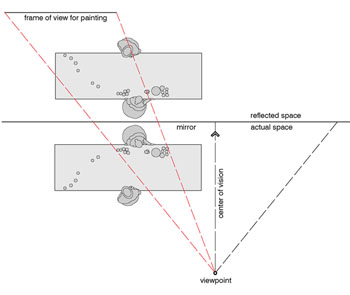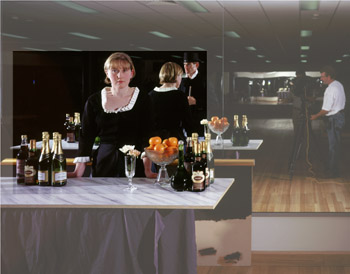A Bar at the Folies-Bergère has generated much speculation and debate. Focusing on biographical, social, or art historical contexts, scholars have constructed elaborate interpretations based on repeated assumptions about the visual inconsistencies or outright "errors" of Manet's painted reflections.
|
Taking a more technical approach, a few scholars have sought to resolve the painting's spatial and optical conundrums. One recent study, by Dr. Malcolm Park, shows that the picture conforms more truthfully than suspected to a one-point perspective view. The photographic reconstruction and diagram shown here illustrate that the scene can be understood as constructed from a viewpoint positioned to the right of the bar arrangement. Manet shows just a small section of the wider view encompassed from this position. This "offset" scheme accounts for the more conspicuous "errors" of Manet's painted reflections, showing them to be, in fact, subtly dissembled truths.
In light of this account, the conversation that many have assumed was transpiring between the barmaid and gentleman is revealed to be an optical trick—the man stands outside the painter's field of vision, to the left, and looks away from the barmaid, rather than standing right in front of her. The barmaid's frontality is also deceptive. Rather than standing parallel to the bar and looking straight ahead, she stands slightly askance, facing the offset viewpoint. |
 |


Arrangement of the bar and its reflected image, viewed from above, showing the "offset" viewpoint. Computer-generated diagram by Malcolm Park, with the assistance of Darren McKimm. Courtesy of Malcolm Park |


Photograph showing a reconstruction of the bar arrangement as seen from the offset viewpoint, 2000. Photograph by Greg Callan Courtesy
of Malcolm Park |
 |
Most ironically, the reflected edge of the bar, which in an offset view would tilt more acutely to the right, is revealed to be a visual decoy, leading us to believe that the vanishing point lies directly behind the barmaid. Thus, the paintings most obvious perspectival clue turns out to be its most subversive perspectival violation. Rather than diminishing Manet's art, this explanation only underscores how masterfully his work teases and confounds our habits of looking, and how rewarding prolonged attention to it can be.
Dr. Malcolm Park is an independent art historian resident in Australia. His research on A Bar at the Folies-Bergère first appeared in his doctoral dissertation, Ambiguity, and the Engagement of Spatial Illusion Within the Surface of Manet's Paintings (Sydney: University of New South Wales, 2001). |